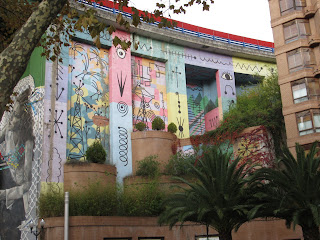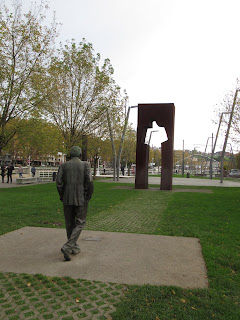Before leaving Bilbao, we wanted to see a few last sights in the city down by the Nerion River. We walked over a pedestrian bridge and along the riverfront to get another view of the fantastic Guggenheim Bilbao, passing many energetic morning joggers and walkers also taking in the beautiful sights even though it was a dreary day. It was a lovely way to start the day before being cooped up in the car for four plus hours.
The sculpture by Joanna Vasconcelos, titled Solitaire, was made of gold-colored alloy wheel rims, crystal whiskey glasses and laminated glass!
The cloister portal took 270 days to complete.
The splendid Golden Staircase was built in 1523 to make adjustments to connect to the street outside because leveling of the ground was necessary to build the cathedral.
The Constables of Castile were sculpted in Carrara marble.
Griffins were depicted on the gilded wrought iron gate.
When the sun shines, the museum's titanium shell glistens. Obviously, it didn't that day! In the foreground was Louise Bourgeois's spider sculpture that we'd seen close up a couple of days previously when we'd visited the museum.
We both loved the street art under the overpass.
The Zubuzuri,
Basque for White Bridge, is considered to be the most striking of the bridges
crossing the Nerion and an iconic feature of Bilbao’s new cityscape since its
completion in 1997.
The sculpture depicted Ramon Rubial Cavia, a Basque leader.
It was a little freaky walking under the spider sculpture!
This was the first time we had a sense that Frank Gehry’s design
of the Guggenheim Bilbao looked like the billowing sails on a ship. It had been fascinating
being able to see the museum from different angles.
Another unusual sculpture at the Guggenheim Bilbao! Bilbao wasn’t the kind of city that stunned us with its physical beauty but “its riverfront landscapes and quirky architecture and its shimmering titanium landmark, Museo Guggenheim Bilbao” plus its proximity to the nearby Basque towns of San Sebastian and Guernica had made it the perfect stopover for us for several days.
Our last sight of Bilbao was of the massive monument in the Sacred Heart of Jesus Square.
It may have been a longish drive southwest toward Salamanca, our destination for the next few days, but the mountain scenery was stunning.
Rather than drive nonstop to Salamanca, we decided to stop in Burgos, a city in north central Spain famous for its French Gothic 13th century cathedral. I couldn't help but smile when we saw this couple!
Parking several blocks away gave us the chance to discover more of Burgos than only its cathedral.
Construction of the Gothic cathedral began in 1221 over the remains of an old Romanesque church under the orders of King Ferdinando III. Most of the work was completed by the end of the 13th century though it went underwent further transformations in the following centuries. Burgos was the capital of Castile and the Leon Kingdom in 1221. The first stone was laid following the models of the French cathedrals of Notre Dame and Nantes.
The cathedral overlooked a massive square in the center of Burgos.
The cloister portal took 270 days to complete.
The Doorway to Paradise or the Black Door was built in 1495, 200
years after the doorway to the cloister.
Fourteen statues represented the prophets, the King of
Israel, patriarch angels.
On the right hand side was a representation of King David and
the prophet Isaiah announcing Jesus’ arrival.
The Visitation Chapel was built in 1440 so the bishops would be buried here.
The Chapel of San Juan de Sahagun included murals of St.
Mary.
The 16th century Chapel of the Presentation included the Virgin in the Temple, added from 1521-1524.
Behind the choir was an alabaster statue of St. Peter, the symbol of the keys, and St. Paul with the sword.
The 16th century Chapel of Conception of St. Ana:
The statue depicted Bishop Luis de Vicuna’s family arriving with its heraldry.
A lovely 16th century Flemish tapestry:
The elegant floral Gothic art walls were covered with sepulchers.
The sculptures were so delicate and realistic.
The 15th century priestly vestments were made of velvet.
The splendid Golden Staircase was built in 1523 to make adjustments to connect to the street outside because leveling of the ground was necessary to build the cathedral.
Angels and griffins were some of the designs on the staircase:
The Chapel of Constables of Castile included three altarpieces, each with beautiful sculptures.
The great coat of arms belonged to the Constables, the founders of the chapel.
The Constables of Castile were sculpted in Carrara marble.
The High Cloister spanned two floors. Burial places and religious processions took place on the top level. The bottom level was reserved for social and community use.
The Chapel of Corpus Christi:
With his long flowing hair, this was the most unusual depiction of Jesus Christ I can recall seeing.
The lovely 15th century staircase led to the cathedral archives.
The Cathedral Museum displayed the most important items belonging to the cathedral, highlighting its art which was an expression of its faith.
This was the first of many extremely ornate monstrances we saw in Spain. A monstrance, for those unfamiliar with Catholic religious items, is the open or transparent receptacle in which the consecrated Host is placed for veneration.
The cathedral's Lower Cloister:
This surely had to be one of the most unusual statues in any church we'd seen.
The Lower Cloister kept adding on more and more chapels through the centuries. It was absolutely magnificent.
I thought it strange and unfortunate that when we paid for the entrance tickets, we only saw the cathedral's tourist sights, not the prayer space.
I think this was Burgos
City Hall.
I was so glad we’d detoured to Burgos for a couple of hours to get at least a sense of the city and tour its magnificent cathedral before driving onto Salamanca, a two-hour drive away, and our destination for the next few days. Plaza Mayor, the city's main square, was so gorgeous at night. Many people regard the plaza, built from 1729 to 1755, to be the grandest in Spain. While most European squares honor a king or a saint, this golden-toned square, ringed by famous Castilians, was for all the people.
Travel writer Rick Steves describes Plaza Mayor as having
long been Salamanca’s community living room. As the most important place in
town, it was always hosting some kind of party. We could imagine the excitement
when, until 1893, bullfights were held in the square. I loved Steves’ description
of an earlier time when girls would promenade clockwise around the colonnade
and the boys would cruise counterclockwise, looking for the perfect queso or
cheese, as they called a cute dish!
The square niches above the colonnade surrounding the plaza depicted writers such as Miguel de Cervantes, heroes and conquistadors such as Christopher Columbus and Hernan Cortes, as well as numerous kings and dictators such as Francisco Franco.
The Town Hall, with its clock, overlooked the square.
We found a delightful restaurant just off the plaza where our waiter surprised us with complementary tapas. Steven then had a pizza margherita and I chose something a little more adventurous, the Iberian pork specialty. My dish was very tender but very much on the greasy side.
Next post: Salamanca's cathedrals and so much more.
Posted on December 26th, 2018, from our home back in suburban Denver after traveling for well over four months!





































































































No comments:
Post a Comment